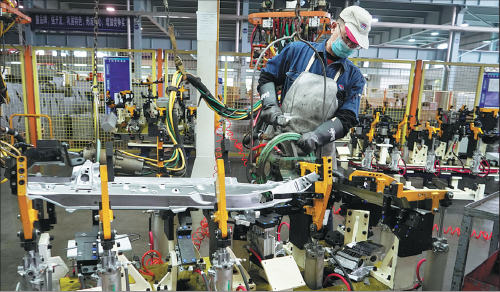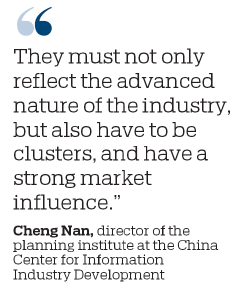Manufacturing clusters key to economic growth
Areas to promote development of industries include integrated circuits, aerospace, marine
A friendly competition of sorts is unfolding among major Chinese cities as the nation highlights its determination to sharpen its industrial capabilities by building up competitive advanced manufacturing clusters.
An advanced manufacturing cluster refers to an industrial grouping formed by a large number of companies and institutions in proximity that carry out mutual cooperation and exchanges. It is considered to be an advanced form of industrial division of labor and agglomeration development, and is part of China's push to pursue high-quality development of manufacturing, experts said.
China's 14th Five-Year Plan (2021-25) highlights efforts to cultivate advanced manufacturing clusters and to promote the development of key industries including integrated circuits, aerospace, marine engineering equipment, robots, advanced rail transit equipment, advanced power equipment, engineering machinery and medical equipment.
Cheng Nan, director of the planning institute at the China Center for Information Industry Development, a Beijing-based think tank, said that previously a large number of industrial parks relied on transportation and geographical convenience, abundant resources, policy dividends and other factors to bring about cost advantages, which have attracted enterprises to concentrate on specific areas. But such approaches are just a scale expansion strategy.
"The advanced manufacturing clusters, however, are based not just on physical proximity among industrial enterprises, but on deeper cooperation among companies to promote the development of local economies," Cheng said.
The Ministry of Industry and Information Technology, China's top industry regulator, recently published a list of 25 selected winners that were named advanced manufacturing clusters after fierce competition among cities across the nation. A total of 21 cities in nine provinces and municipalities made it onto the list, which is known as the "national manufacturing team", with some cities hosting more than one site.
Jiangsu and Guangdong, two provinces traditionally known for their manufacturing strength, have six industrial clusters each on the list. They were followed by Zhejiang province with three clusters.
Experts said the competition is like a horserace and it is designed to select leaders in different industries under unified evaluation standards so that they can undertake the national mission of building advanced manufacturing clusters and then participate in global competition and cooperation on behalf of China to become "world champions" in their respective areas.
Cheng said the competition considers both qualitative and quantitative factors and the list is a result of a comprehensive evaluation."They must not only reflect the advanced nature of the industry, but also have to be clusters, and have a strong market influence," Cheng added.
Cities across China have made major efforts for the competition. As early as 2019, Changsha, capital of Hunan province, established a special working group to promote the development of a construction machinery industry cluster in the city.
The working group brought in leading construction machinery companies such as Sany Group, Zoomlion and China Railway Construction Heavy Industry and they worked together to achieve breakthroughs in 22 key technologies such as high-performance engines. Their total research and development investment increased from 5.26 billion yuan ($806 million) in 2018 to 8.25 billion yuan in 2019. In the end, Changsha was on the "national manufacturing team" list.
But it is worth noting that no manufacturing clusters from the Beijing-Tianjin-Hebei region and northeast China-an important heavy industry base-made their way onto the list.
He Ying, director of the Institute of Technology and Standards of the China Center for Information Industry Development, said more efforts are needed in North China to build an innovation-friendly environment.
Beijing ranks third in its innovation capacity in China. Neighboring Tianjin and Hebei province are further behind, which helped keep the Beijing-Tianjin-Hebei region off the list, He said.
For key advanced manufacturing clusters, more support measures are in the pipeline. The planning department at the Ministry of Industry and Information Technology said that it will further improve top-level design, carry out special action plans for the development of advanced manufacturing clusters, accelerate the strengthening of the industrial chains, optimize the layout of manufacturing innovation centers and cultivate a group of global competitively large enterprises and specialized small and medium-sized enterprises.
Relying on market-oriented mechanisms, efforts will be made to give these clusters room to innovate governance models, play the role of government investment funds, plan a number of major projects and advance the upgrade of industrial bases and the modernization of the industrial chain, the planning department added.
Local governments are also pouncing at the opportunity to speed up development and anchor goals of cultivating industrial clusters with annual revenues exceeding more than 100 billion yuan and even 1 trillion yuan during the 14th Five-Year Plan period.
Nanjing, capital of Jiangsu province, for instance, said it aims to grow the output value of its new smart power grid equipment cluster to exceed 400 billion yuan by 2025.
Zhuzhou, a city known for its railway equipment manufacturing in Hunan province, proposed to build a world-class advanced rail transit equipment industrial cluster, with an annual output of more than 200 billion yuan by 2025.
The Guangzhou-Shenzhen-Foshan-Dongguan intelligent equipment industrial cluster in Guangdong province said it aims to build a world-class intelligent equipment industrial cluster with an output value of more than 1 trillion yuan by 2025, and form an intelligent equipment industrial system with active innovation, optimized structure and leading scale.
Meanwhile, talent, capital and other resources are also flooding to these clusters. During the 14th Five-Year Plan period, Shanghai's integrated circuit cluster will invest another 300 billion yuan, and introduce targeted policies to facilitate talents to settle down in Shanghai, offer individual tax reductions, cultivate small and medium-sized enterprises and provide industrial fund support to ensure industrial development.
The Shenzhen municipal government also said it will support the construction of key projects for the Shenzhen-Guangzhou high-end medical device cluster, play a guiding role vis-a-vis government funds, attract industrial investment funds and venture capital institutions as well as establish a full-chain capital support method.
The cities' efforts to jump onto the bandwagon of building advanced manufacturing clusters come as China re-highlighted its determination to stabilize the proportion of the manufacturing industry in the GDP.
The proportion of the manufacturing industry in China's GDP has gradually declined since 2015. Currently, manufacturing output only accounts for about 27 percent of China's GDP, according to Huang Qunhui, director of the Institute of Economics at the Chinese Academy of Social Sciences.
Miao Wei, deputy director of the Economic Affairs Committee of the 13th National Committee of the Chinese People's Political Consultative Conference, recently said that a notable decline of manufacturing business in China's GDP will not only drag down the current economic growth and affect urban employment, but will also generate potential industrial safety hazards and weaken the country's anti-risk capabilities and global competitiveness.
It will take at least three decades to achieve the goal of becoming an advanced manufacturing powerhouse, said Miao, who is also a former minister of industry and information technology.
masi@chinadaily.com.cn

















